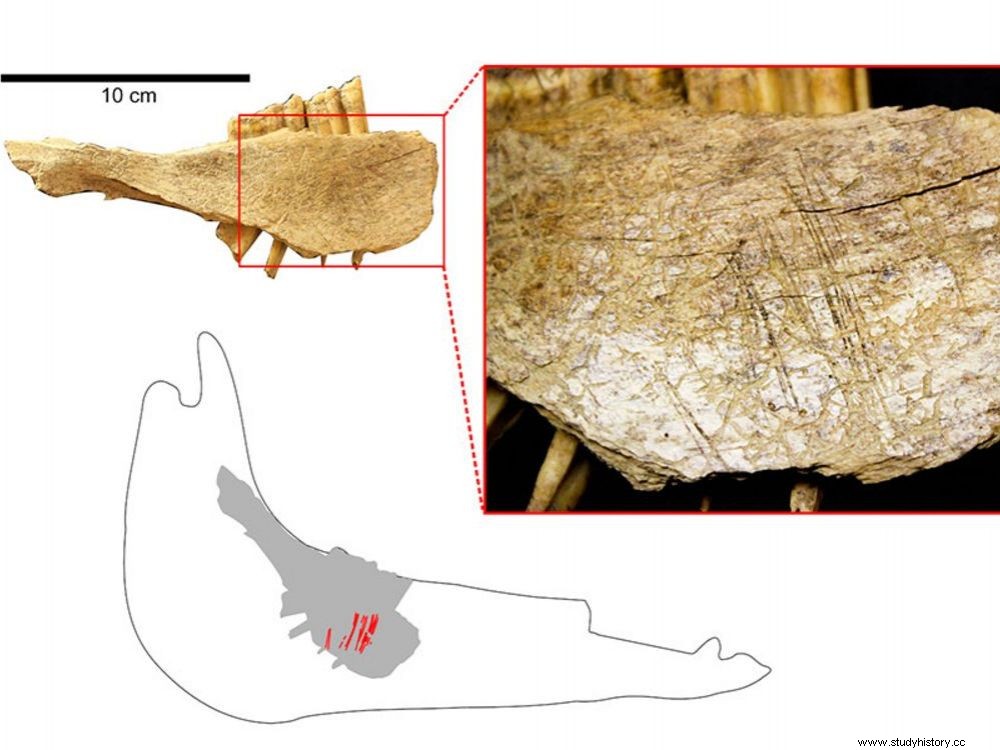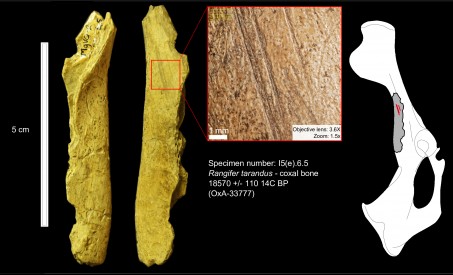Bone remains unearthed at Blue Fish Cave, caves located in Canada, prove that humans had reached North America 10,000 years earlier than previously thought.

Horse mandible from the site of Blue Fish Cave, Yukon (Canada). It contains many traces of straight and parallel cuts, which indicate a removal of flesh made with a carved stone tool.
AMERICA. The ancient arrival of the first humans in America jumps back in time… by 10,000 years! The origin of human presence on the North American continent would indeed date back to 24,000 years, and not 14,000 years according to conventional estimates. This new dating brings water to the mill of the partisans of a very ancient occupation in North America, this subject being regularly a subject of contention within the scientific community. While studying the bone remains unearthed at Blue Fish Cave on the banks of the Blue Fish River in northwestern Yukon, Ariane Burke and Lauriane Bourgeon of the Department of Anthropology from the University of Montreal (Canada), made their discovery. Thousands of fragments of bones from mammoths, bison, caribou and especially horses - typical animals of the Pleistocene fauna* - had been exhumed between 1977 and 1987 by the Canadian archaeologist Jacques Cinq-Mars and kept at the Museum of History from Gatineau, to Quebec.
V-shaped notches are due to cut stone tools
But it was by re-examining them using a stereomicroscope (high-resolution binocular magnifying glass) that Lauriane Bourgeon identified indisputable traces of human intervention, as reported in an article published on January 6, 2017 in the journal PLOS One . V-shaped indentations on the bony surfaces believed to be from chipped stone tools. Microblades had indeed been found in quantity on the site. They would have been used to cut and slice the flesh and cartilage during the butchering of the carcasses. Fifteen bone samples had changes attributable to these human activities, while around 20 others were classified as highly probable. Deep cutmarks were thus found on a fragment of caribou pelvic bone, and others on a long bone belonging to a Dall sheep. The strong fragmentation of the bone assemblies also caught the researcher's attention. “When carnivorous animals leave bones behind, the bones remain relatively complete. Humans, they break them with their hammer to extract the marrow, which could explain the large quantity of fragmented bones found in the caves of Bluefish “, she commented in Western Digs.

Fragment of caribou pelvic bone showing traces of removal made using cut stone tools during butchering. © Lauriane Bourgeon
Radiocarbon analyzes were then carried out by Thomas Higham at the dating laboratory of the University of Oxford (United Kingdom). And this is how the oldest fragment with anthropogenic traces, a horse's mandible, could be dated... to 24,000 years old! This must have delighted Jacques Cinq-Mars himself, who had already put forward the then controversial hypothesis of the human occupation of these caves. "There is now evidence that East Beringia was inhabited during the last ice age", said Ariane Burke. This immense territory stretching from the Mackenzie River in the Northwest Territories to the Lena in Russia would have played a central role in the initial dispersal of the first populations from Asia to America. Still according to this Canadian anthropologist, studies in population genetics have shown that a group of a few thousand individuals from Siberia lived in Beringia in isolation between 15,000 and 24,000 years ago, during the last glacial maximum. . “Our results show that humans occupied the site of Blue Fish Cave on several occasions as early as 24,000 years before the present, and that they hunted caribou and horses in particular, well before the latter's extinction in Beringia", concluded Lauriane Bourgeon. Still in progress, this study should provide other data.
